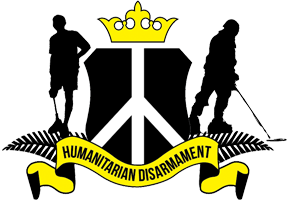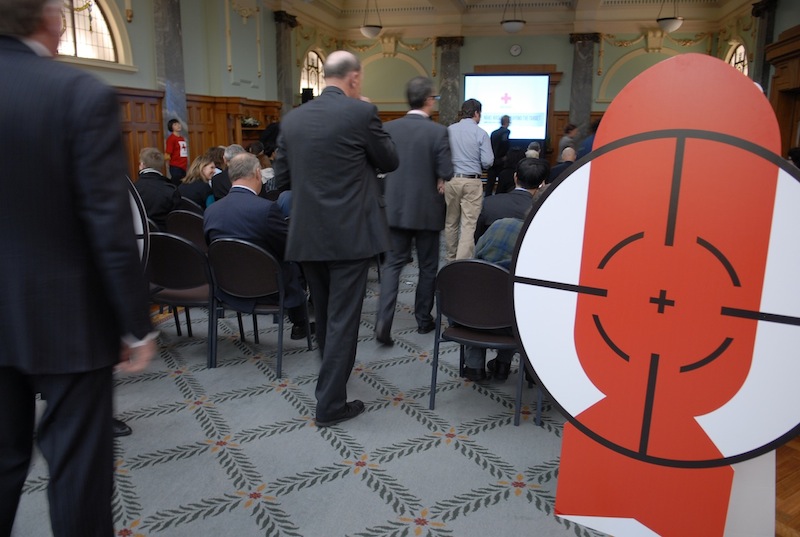On 4-5 March 2013, a highly-anticipated conference to consider the humanitarian impact of nuclear weapons was convened by Norway in Oslo. This write-up covers some of the highlights from this latest humanitarian disarmament initiative, which seeks to reframe the debate on nuclear weapons in humanitarian terms and initiate swift action by like-minded states in support of the abolition of nuclear weapons.
A total of 127 countries participated in the Oslo conference, in addition to UN organizations, International Committee of the Red Cross (ICRC), and civil society representatives from the International Campaign to Abolish Nuclear Weapons (ICAN). The broad participation by two-thirds of all UN member states was described by Norway as “recognition that this is an issue of fundamental significance for us all.”
The Oslo conference was billed as “an arena for a fact-based discussion of the humanitarian and developmental consequences of a nuclear weapons detonation.” Participants were invited to take stock of the consequences of and ability to respond to any use of nuclear weapons, a method that New Zealand said, “renewed the opportunity for us to live up to our collective responsibility to advance nuclear disarmament.”
The conference website lists three “key points” or findings from the presentations and discussions in Oslo.
First is the overwhelming acknowledgment from governments and humanitarian organizations such as the ICRC and Norwegian People’s Aid that no effective relief or humanitarian response would be possible in the case of a nuclear weapon detonation. The conference found that it “might not be possible to establish such capacities, even if it were attempted.” New Zealand provided the sobering experience of the 2011 Christchurch earthquake to reflect on the impossibility of preparing for a nuclear detonation.
A second point was agreement that the use and testing of nuclear weapons has been proven to have “devastating” immediate and long-term effects. As Patricia Lewis noted there are no “small” mistakes with nuclear weapons – “once you’ve detonated them its a huge mistake.”
Survivors of nuclear weapons testing and use provided real-life examples of the historical experience of nuclear weapons and demonstrated their forceful advocacy skills in demanding action on nuclear disarmament.
Mr. Karipbek Kuyukov, an activist and painter from Kazakstan who was born without arms, provided a visible reminder to all delegates of the long-term effects of nuclear weapons testing. In his address to the Oslo conference, Kuyukov said he believed that the “hundreds of nuclear test victims who are no longer with us watch upon us with approval and countenance.”
Mr. Terumi Tanaka, a survivor, or “Hibakusha,” from the atomic bombing of Nagasaki, told the conference that “such inhumane, immoral human acts must never be allowed” and affirmed that “the Hibakusha’s experience must be the departure point when we discuss the humanitarian impact of nuclear weapons.”
The third finding of the conference was that “the effects of a nuclear weapon detonation, irrespective of cause, will not be constrained by national borders.” This message should resonate with states and people, especially youth, seeking to build a movement to abolish nuclear weapons “now” rather than within their lifetimes or their children’s lifetimes.
During the Oslo conference a number of states, including Austria, Costa Rica, Ecuador, Malaysia, Nigeria, South Africa, and Switzerland, expressed interest in further exploring the discourse on the humanitarian impact of nuclear weapons.
In the final session Mexico announced its intent “as a responsible global actor” to host a follow-up meeting to the Oslo conference. New Zealand committed to “wholeheartedly join in all work” including “any process following on from this meeting and from Mexico’s, that brings us closer to our goal: the elimination of nuclear weapons.”
ICAN co-chair Rebecca Johnson of Acronym Institute left governments with this message: “When you leave here, please continue to think deeply and constructively about what is possible, necessary and achievable to prevent further unacceptable humanitarian harm from these weapons of mass suffering.”
At the conclusion of the conference, the Norwegian Minister of Foreign Affairs, Espen Barth Eide, tweeted that the deliberations had “reframed” the discourse on nuclear weapons and “introduced new sense of urgency.” Thomas Nash, Director of Article 36, described the Oslo conference as a “pivotal move” and its outcome as “embarking on a road that can only lead to a treaty to ban nuclear weapons.”
The five permanent members of the UN Security Council—all nuclear weapon states—declined to attend the Oslo conference, as did Israel, North Korea, and Pakistan. Some P5 diplomats claimed to be “following the presentations” online via social media. There was some truth to this as the Oslo conference was held at exactly the same time as the Conference on Disarmament (CD) in Geneva
At the CD, US Ambassador Laura Kennedy emphasized the need for a “practical, step-by-step approach to disarmament.” Similarly the UK defended its support for a “step by step approach to disarmament” and pleaded for “help” to “unblock the CD.” China and Russia emphasized process over substance in their CD statements, focusing predictably on the intractable problems faced in the CD. China’s Ambassador Wu Haitao warned that at nuclear disarmament mechanisms outside the CD and UN system would undermine existing processes and at the same time divert the already limited budget. Similarly, Russia’s Ambassador Borodavkin cautioned that failure to leave nuclear disarmament matters in the CD in the presence of all states that have nuclear potential could “pull apart the CD agenda,” leading to a collapse of disarmament mechanisms.
The P5 decision to stay away from the Oslo conference was described by some as a “strategy failure” as these states will not be able to directly influence the next stage of the process or its eventual outcome if they do not participate. Richard Moyes of Article 36 noted, “the train is pulling out of the station but the UK is stuck on the platform.”
Promoters of the Oslo conference pitched it as helping to “strengthen and reinforce” existing international law, namely the Nuclear Non-Proliferation Treaty and the Comprehensive Test Ban Treaty, as well as nuclear-weapon-free zones, national laws, and other mechanisms and measures.
The Oslo conference enabled anti-nuclear states to channel their exasperation with the failure of existing processes into forward-looking momentum to advance nuclear disarmament with other like-minded states. New Zealand asked, “Why should nuclear disarmament – any more than nuclear non-proliferation – be promoted only in one forum? We see no contradiction in promoting nuclear disarmament inside the NPT and outside it here in Oslo.”
Civil society provided strong support to the Norwegian organizers of the Oslo conference. At a forum convened by the International Campaign to Ban Nuclear Weapons prior to the governmental conference, more than 500 activists from 70 countries brainstormed on how to ramp up efforts “to get negotiations started on a treaty banning nuclear weapons.”
The civil society forum frequently reflected on lessons from the campaigns for two prime examples of humanitarian disarmament law: the 1997 Mine Ban Treaty and 2008 Convention on Cluster Munitions. This included how the treaties were achieved via unconventional diplomatic initiatives that “shape the rules to suit the goal, rather than shape goal based on what rules allow.” Bill Pace, who campaigned for the establishment of the Rome Statute that created the International Criminal Court, warned that countries cannot be allowed to negotiate treaties down to lowest common denominator as they most likely won’t even sign the final product.
These are among many lessons and findings of the Humanitarian Disarmament Campaigns Summit that Human Rights Watch convened in New York in October 2012 with the support of 14 other NGOs. It remains to be seen if they will be taken into consideration when the final negotiations of the Arms Trade Treaty open in New York on 18 March.
For more information, see ICAN’s website: www.icanw.org
A total of 127 states participated in the Oslo conference on the humanitarian impacts of nuclear weapons: Afghanistan, Albania, Algeria, Angola, Argentina, Armenia, Australia, Austria, Bahrain, Bangladesh, Belarus, Belgium, Bhutan, Bosnia and Herzegovina, Brazil, Brunei Darussalam, Burkina Faso, Burundi, Cameroon, Canada, Central African Republic, Chile, Colombia, Cook Islands, Costa Rica, Cote d’Ivoire, Croatia, Cuba, Czech Republic, Democratic Republic of Congo, Denmark, Ecuador, Egypt, El Salvador, Eritrea, Estonia, Ethiopia, Fiji, Finland, Gambia, Georgia, Germany, Ghana, Greece, Guatemala, Guinea Bissau, Holy See, Honduras, Hungary, Iceland, India, Indonesia, Iran, Iraq, Ireland, Italy, Jamaica, Japan, Jordan, Kazakhstan, Kuwait, Kyrgyzstan, Lao PDR, Latvia, Liberia, Libya, Lithuania, Luxembourg, FYR Macedonia, Madagascar, Malaysia, Mali, Mauritius, Mexico, Moldova, Mongolia, Montenegro, Morocco, Mozambique, Myanmar/Burma, Nepal, Netherlands, New Zealand, Nicaragua, Nigeria, Norway, Pakistan, Paraguay, Peru, Philippines, Poland, Portugal, Qatar, Republic of Korea, Romania, Sao Tome and Principe, Saudi Arabia, Senegal, Serbia, Sierra Leone, Slovakia, Slovenia, South Africa, South Sudan, Spain, Sri Lanka, Sudan, Swaziland, Sweden, Switzerland, Tajikistan, Tanzania, Thailand, Togo, Trinidad and Tobago, Tunisia, Turkey, Tuvalu, Uganda, Ukraine, United Arab Emirates, Vanuatu, Venezuela, Vietnam, Yemen, Zambia and Zimbabwe.
Photo – Parliamentary launch of a New Zealand Red Cross campaign to “make nuclear weapons the target” (c) Mary Wareham, August 2012.


Leave a Reply